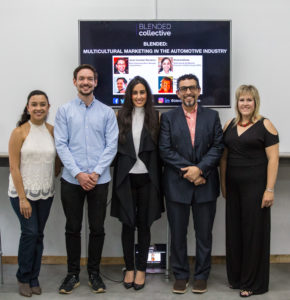Left to right: Lydia Michael, Maria Arellano, Florian Kotte, Barbara Toboy, Javier Guzman Barcenas. © Haintso Rakouth Photography
Our second Blended panel was held at the co-working space Bamboo Detroit last month to have a discussion around multicultural marketing in the automotive industry with a focus on Detroit. Unlike traditional marketing panels, our event featured panelists with roles in the auto industry whose functions overlap with marketing, or at least require marketing to stay top of mind when executing daily tasks.
Meet The Panelists
- Moderator/Host: Lydia Michael, CEO & Founder, Blended Collective
- Florian Kotte, Test & Validation Engineer, German Supplier
- Maria Arellano, Multicultural Art Director, previously with Leo Burnett and UniWorld Group
- Barbara Toboy, Senior Analytics Manager, GTB
- Javier Guzman Barcenas, Plant Communications Manager, General Motors
The general consumer market has become equivalent with the multicultural market. How is this reflected in the auto industry?
Pay attention to what it looks like to communicate cross-culturally. “If you think about it, we all are multicultural. We live in a melting pot of culture and diversity. For example, I read that the Hispanic population of the US will become the majority ethnic group by 2060. Auto companies are realizing that it’s more than just one culture consuming products. Consumers are looking for brands that truly speak to them rather than putting on a façade. That’s why automotive companies have been paying more attention to what it would look like to speak to their consumers across various cultures.” – Barbara Toboy
Talk about what strategies you use to be all things to all people — to appeal to one audience, without alienating another audience. How do you make it work for everybody?
Avoid big changes to the product, make small adjustments. “Working with electric car components, we have a very limited budget and want to sell it to every market with very minor changes. We were building parts for German cars, which are generally smaller. Whenever we want to bring products over to the US, you see that the cars a lot bigger and there’s more space for parts. So, you have to adapt accordingly for a different market. And sometimes there are technologies that are not available in certain markets, so you have to also adjust the design, which involves costs that weren’t accounted for.” – Florian Kotte
Have conversations about inclusivity, but target different segments in ways that are relevant to customers. “It’s not realistic to think that you’re always going to check all of the boxes for all populations when creating marketing campaigns. This is why you see many more targeted ads or pieces of communication to talk to one particular group of people to not try to sell everything to everybody at once. In terms of being sensitive and inclusive, we do a lot to come together and talk about this.” – Maria Arellano
Tap into the knowledge of those who are experts in niche markets. “We partner with boutique local agencies or have in-house staff that are subject matter experts for the audiences we are trying to reach. One agency focuses solely on the Hispanic market while another focuses on the African-American audience. We market to them where they gather and in a way that speaks to them personally, whether language or lifestyle.” – Barbara Toboy
Can you give an example of a company outside of automotive you find successful at multicultural marketing, which can be translated to the auto field?
Tide, because everyone needs to do laundry. “If you look at Tide, it is one of the best examples of being inclusive to its multicultural audience. By displaying multiple genders, races, and ages, it promotes diversity and inclusion across the board. Many of their commercials show different members of the family across the generations. Every commercial focuses on inclusivity. Tide is the leader in its category, and also one of the leading brands among millennials.” – Audience
FIFA World Cup, because everyone speaks the same language – the product. “One example of great multicultural marketing is the FIFA World Cup. Every four years, millions of people across several continents enjoy the tournament. It is one brand with several localized messages across several countries to the participant and non-participant. Everyone speaks the same language – Soccer. Everyone looks for the same objective – winning the World Cup.” – Javier Guzman Barcenas
 This event is part of our quarterly speaker event series. The next Blended panel will take place on September 5, 2018 in partnership with Detroit Design Month about The Intersection of Culture x Design. Let’s keep the conversation going! Share your thoughts on Instagram, Facebook or Twitter using the hashtag #BlendedCollective.
This event is part of our quarterly speaker event series. The next Blended panel will take place on September 5, 2018 in partnership with Detroit Design Month about The Intersection of Culture x Design. Let’s keep the conversation going! Share your thoughts on Instagram, Facebook or Twitter using the hashtag #BlendedCollective.
© Haintso Rakouth Photography for Blended Collective


